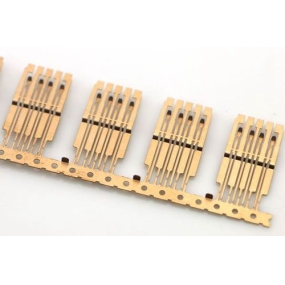Firstly, the cutting comparison between modern five axis CNC Machining centers and traditional three-axis CNC machining centers. A five axis machining center is a traditional three-axis machining center that completes five axis linkage machining by adding a rotating axis to the X-axis. The rotation axis that rotates around the X axis is defined as the A rotation axis. The processing range of the A axis is between 30 and negative 120. A rotary table is set in the middle of the A rotation axis, which can rotate around the Z axis and is commonly referred to as the C rotation axis. The working range of the C rotation axis is 360 revolutions, and the combination of these two rotation axes can complete the machining of all surfaces except for the installation surface in one workpiece clamping, with a smaller division value of 0.001, so that there is no blind spot on the machining surface.
Secondly, when machining the side of the workpiece, the tool length of a five axis CNC machining center is much shorter than that of a three-axis machining center, which greatly improves rigidity and machining accuracy. When dealing with chaotic and heterogeneous spatial structures, the linear motion of a three-axis machining center is often inadequate, while a five axis linkage machining center can complete the machining of special parts through the deflection angles of the A and C axes.
Then, the five axis linkage machining skill also has the characteristics of simple spindle structure, good spindle rigidity, and relatively low production cost. Quando pretium quinque asses CNC machinatorium centrorum nunc altum est, in futuro, cum continuo profunditate interrogationis machinatorium, quinque asses machinatorium CNC propinquationes amplius erunt.


 English
English Spanish
Spanish Arabic
Arabic French
French Portuguese
Portuguese Belarusian
Belarusian Japanese
Japanese Russian
Russian Malay
Malay Icelandic
Icelandic Bulgarian
Bulgarian Azerbaijani
Azerbaijani Estonian
Estonian Irish
Irish Polish
Polish Persian
Persian Boolean
Boolean Danish
Danish German
German Filipino
Filipino Finnish
Finnish Korean
Korean Dutch
Dutch Galician
Galician Catalan
Catalan Czech
Czech Croatian
Croatian Latvian
Latvian Romanian
Romanian Maltese
Maltese Macedonian
Macedonian Norwegian
Norwegian Swedish
Swedish Serbian
Serbian Slovak
Slovak Slovenian
Slovenian Swahili
Swahili Thai
Thai Turkish
Turkish Welsh
Welsh Urdu
Urdu Ukrainian
Ukrainian Greek
Greek Hungarian
Hungarian Italian
Italian Yiddish
Yiddish Indonesian
Indonesian Vietnamese
Vietnamese Haitian Creole
Haitian Creole Spanish Basque
Spanish Basque









